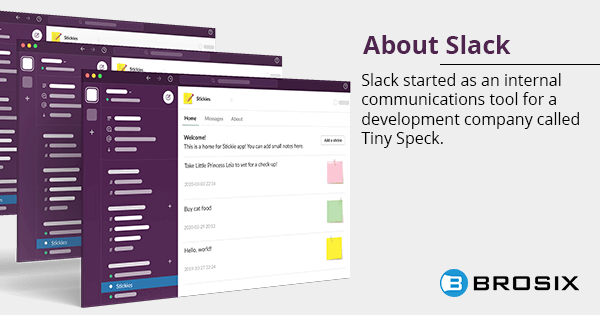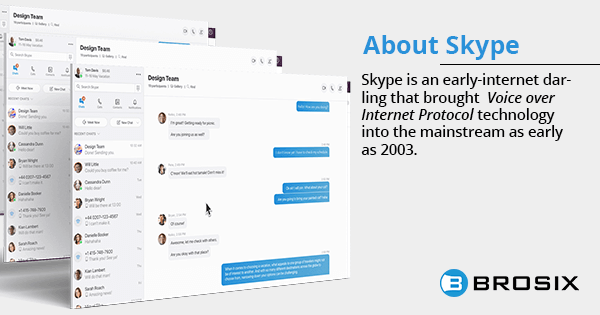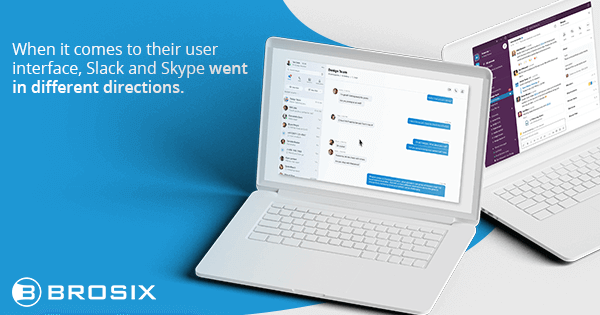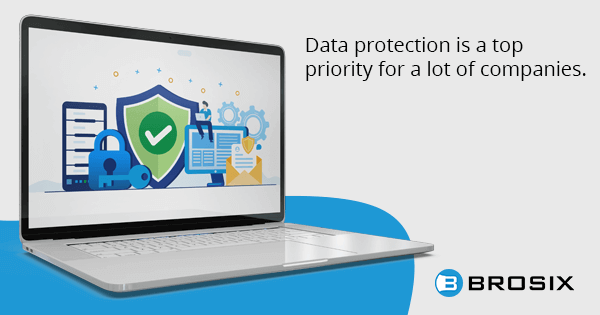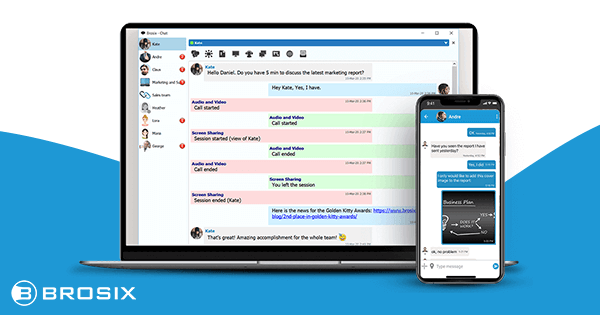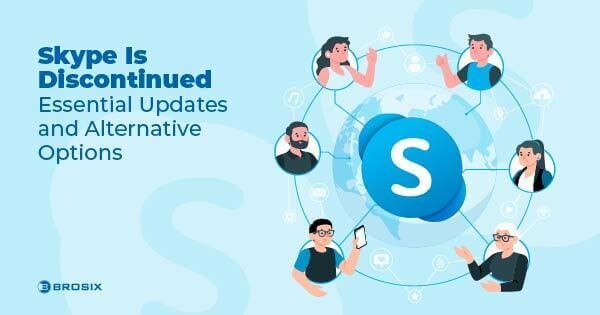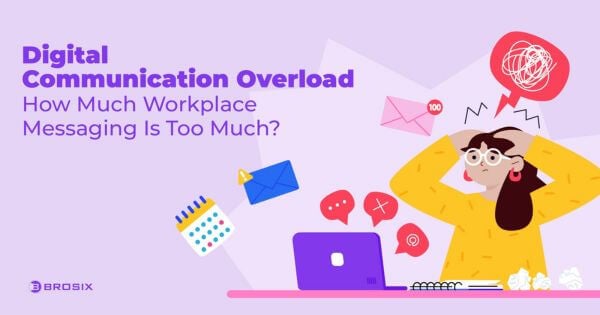Streamlined team communication is extremely important, especially if you’re running a team of remote workers. You want your team members to get all messages in time, never miss a notification, and perform a set of more complex actions like sharing files and collaborating on projects.
When it comes to team chat apps, it’s hard to find more popular ones than Skype and Slack. Skype has been the primary means of communication for many businesses for more than a decade, while Slack has revolutionized the industry since it entered the market in 2013. They’re both known as reliable, easy to use, and intuitive.
Which one is the better option for your business? Read on to see how Slack and Skype compare in different categories that are relevant for efficient team collaboration.
About Slack
Slack started as an internal communications tool for a development company called Tiny Speck. It became available to the public in February 2013 and has since reached more than 12 million active Slack users worldwide. It’s known for its innovative use of Channels, a feature that allows for more structured conversations with multiple groups at once.
In late 2020, during the pandemic, Slack was acquired by Salesforce, which is a move that some have characterized as Slack admitting defeat to Microsoft’s Teams platform. This move is supposed to make Salesforce more competitive with the tech giant by entering the enterprise communication market.
About Skype
Skype has been around since 2003. Famous for its video calls, Skype is an early-internet darling that brought VoIP (Voice over Internet Protocol) technology into the mainstream.
It was famously acquired by eBay in 2005 for $2.6 billion and then by Microsoft in 2011 for $8.5 billion. Since then, Microsoft has been trying to transform it from a peer-to-peer to a cloud-based communication model. Skype has undergone several redesigns, shifting from a personal communications app to a business one.
Although Skype is still an efficient app for team communication and video conferencing , there is a case to be made that Skype is being upstaged by Microsoft’s rising star, Teams.
How Did We Compare Them?
We had five criteria in mind for our detailed comparison between these two apps.
- Pricing: While both Slack and Skype have their free versions, both of them come with some limitations. Their paid plans vary both in terms of price and features, so we’ll take a close look at those in this section.
- User interface. Slack and Skype feature quite different designs. In this section, we will cover their key features, as well as customization options and ease of use.
- Advanced features. If you want to use Slack or Skype to organize your workspace in more advanced ways, such as project management or employee training, you might be interested in how these apps handle this. We’ll also get into file sharing, chat history, and other things that make communication easier.
- Safety. Enterprise communication needs to be as secure as possible from third-party access. Slack and Skype both have some protocols in place, but, as we’re about to see, they also have some privacy concerns.
- Integrations. You can use Skype or Slack as a part of a more complex business suite, and you might be interested in the integrations they offer. Since both of them are now owned by tech giants, you can expect some exciting options in this area.
Now let’s get started with our Skype vs. Slack review and find out which of the two big-name team collaboration solutions is better for your business!
Slack vs. Skype: Pricing
You can use both of these apps for free, albeit with some serious limitations. For example, Slack’s free plan offers only 90 days of chat history and only 1-1 audio and video calls.
Let’s go into more detail.
Slack offers a completely free plan with limited features, a Pro plan at $7.25, Business+ at $12.50, and Enterprise Grid at a custom price, available upon request. All of these prices are per month, per user, and they only apply if you choose to pay annually.
Skype offers unlimited- and fixed-minute calls to landlines and mobiles to people from the USA, India, and countries in North and Central America. The prices start at $2.54 for US citizens and $5.94 for other North American locals.
For occasional calls, one can opt for Skype Credit, a pay-as-you-go option with low rates. Getting a Skype Number for a monthly fee to receive calls from mobiles or landlines is ideal for international communication or staying connected while traveling.
However, it’s important to mention that Skype for Business is being replaced by Microsoft Teams, so investing in Skype might not be a smart decision. You’re much better off using the free version or upgrading to Teams if you like the Microsoft ecosystem.
Slack vs. Skype: User Interface
When it comes to their user interface, Slack and Skype went in different directions. Both are simple to use and have everything you need to improve team communication.
We all know Skype as this small window meant for quick and easy chats. The window becomes larger when you start a video call, and you can change its size at any time. You can even go full screen, at which point the app becomes more like Slack. All your active chats are on the left, and the chat window takes up most of the screen.
The key difference is that Skype is much more streamlined. For example, Slack has your contact’s basic info and conversation details right next to the chat area. On Skype, you have to click on your contact’s profile name to see their details. This action leads to opening a chat window where you can see their status, profile picture, and other information.
Slack’s use of Channels makes the app much better for team conversations. All the information about your current Channel or contact is displayed on the right, where you can see the members, pinned messages, and shortcuts. You can also perform actions like adding members or calling larger groups of people.
The same goes for one-on-one conversations, where clicking on the Info button in the top right corner opens up a section with useful information like their email, time zone, and the files you shared in the conversation.
One of the key advantages of Slack over Skype is the number of customization options. By clicking on your profile picture in the top right corner, you can access Preferences and change all sorts of things to create a chat experience that suits you. You can change the contents of your sidebar, your language, and region, as well as your theme. If you feel particularly creative, you can even create your own theme by changing the color scheme.
Slack vs. Skype: Advanced Collaboration
Slack is more suited to complex team discussions. With threaded conversations, you can easily respond to specific messages without derailing the entire conversation. This can be useful if you don’t see a message in time and you don’t want to go back to a topic that has already passed in a group chat.
Slack is also easier to navigate if you have multiple teams. Each team can have its own channel with a separate topic. You can have separate channels for different teams, projects, or casual topics. You also get #random and #general channels, where you can have less formal conversations to build team spirit and a sense of community.
On the other hand, Skype is a much more streamlined app where communication and collaboration are a top priority. One-to-one conversations are the main focus of the app, along with video calls. And, while team collaboration is possible, it’s not as natural as on Slack.
Both apps also have limits on your file upload sizes. On Slack, that limit is 1GB, while on Skype it’s 300MB. Skype’s limit may be enough.
Skype has a slight advantage when it comes to message history. With the free version, you can view up to two years of chat history. For comparison, Slack’s free plan limits the visibility of files and messages to the last 90 days.
Slack vs. Skype: Safety
Data protection is a top priority for a lot of companies. If you’re using your work instant messenger to share sensitive data about your company and organize private discussions, you want to make sure no one has access to the things being said.
Unfortunately, neither Skype nor Slack offer particularly reassuring safety protocols.
Slack doesn’t use end-to-end encryption, which is a must if you’re looking for a messaging app that protects your data. End-to-end encryption protocols prevent anyone (even the app owners) from viewing your conversations. This should mean that even if they needed to, they wouldn’t be able to access your conversations since they are encrypted with a key that only you and your contact have.
Slack was hacked several times, perhaps most famously in 2015, in an event that prompted the app owners to roll out two-factor identification.
Skype is a little more serious with its safety protocols, as it has end-to-end encryption. However, it also has a history of suspected security flaws and allegedly collaborating with the authorities to allow them access to user data.
Not to get too ahead of ourselves here, both Slack and Skype are likely safe options for most of the general population. But if you’re someone who deeply cares about their privacy and company data, these two apps aren’t famous for their reliable safety protocols.
Slack vs. Skype: Integrations
Finally, Slack and Skype offer a fair amount of integrations to help you turn them into powerful team collaboration tools.
For example, while you can use Slack’s video chat feature, it’s easy to integrate with the most popular video calling apps like Zoom. You can also use Slack’s Skype integration to do the same thing. They also allow you to integrate with calendar apps to schedule meetings, Google Docs to easily collaborate on files, and various productivity apps, such as Trello, to collaborate on projects.
If you feel at home in Microsoft’s business suite, then you’ll find Skype’s integration options appealing as well. If you choose one of the Office 365 plans, you’ll also get access to Outlook, Notes, and other famous apps that make work easier.
Brosix: A Team Chat With More Security
If you don’t like the idea of handling your business communication through apps that don’t have advanced privacy protocols, we recommend checking out Brosix.
Brosix is designed specifically for business instant messaging. It allows you to create a Private Team Network that gives you complete control over the whole communication process. You’re in charge of everything that happens in your network, including features control. You get to decide which users have access to which features.
Brosix also delivers on some more advanced team collaboration features. For example, you get to share unlimited-size files through our secure file transfer protocol. You also have an unlimited chat history and various other advanced options, like screen sharing with a remote desktop that allows you to take control over your contact’s desktop while on a video call.
Slack vs. Skype: Conclusion
Now that we have gone through all the pros and cons of Skype and Slack, we hope we have helped you make a more informed decision and choose one that suits your needs.
Skype and Slack are among the most popular options, but if you’re looking for a more complex solution between the two, we recommend Slack. Skype’s only big advantage is the fact that the free version might be more valuable than Slack’s free version. And, with Salesforce purchasing Slack, you can probably expect some even more interesting options and features for this app in the future.
On the other hand, if you’re concerned about their safety and the lack of advanced options, feel free to try out Brosix. It offers many of the same features with more data privacy through admin control.




